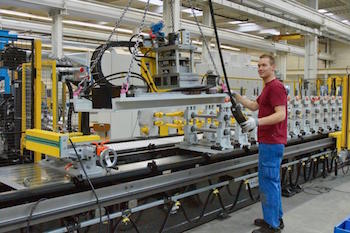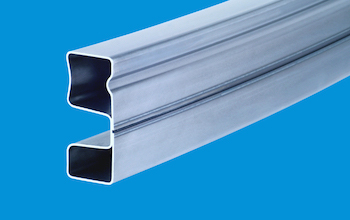
With a relatively low cost and high productivity, rollforming is proving an attractive technology for the manufacture of components
 With a relatively low cost and high productivity, rollforming is proving an attractive technology for the manufacture of components
With a relatively low cost and high productivity, rollforming is proving an attractive technology for the manufacture of components
Dynamically changing markets are increasingly challenging classical business models for suppliers of car body parts. Multifunctional rollforming technologies are facilitating the adjustment of such production lines to fast changing market needs. They open up new business opportunities by their enhanced capabilities to produce completely new products without excessive investment cost. As a result they can considerably reduce business risks.
Because of relatively low costs for tooling and equipment, and high productivity, rollforming represents an attractive technology for the manufacture of automotive components. This is reason enough for many companies to step into this technology. However, often they have to realise that it is hard to gain enough contracts for products with same or similar process requirements, for example rocker panels, in order to make full use the enormous capacity of an up-to-date rollforming line. Consequently, they consider products with differing process requirements.

The analysis of the capabilities of existing rollforming lines demonstrate that this requires often major and expensive modification. Up to now, rollforming lines were designed for fixed sectors for strip feeding, pre-punching, rollforming, welding, post-punching and cutting. Such fixed designs make later adjustments difficult, sometimes impossible, because of limited floor space.
Such experience triggered investigations for new solutions at Dreistern – a German manufacturer of rollforming equipment. It led to the development of a completely new approach for rollforming automotive parts. Dreistern´s engineers called their new technology Multifunctional Rollforming.
The idea was to provide a technology that is capable of producing any rollformed product which is feasible by a combination of rollforming, punching and welding. This capability would enable the rollforming industry to offer its automotive customers a substantially enlarged array of products.
The Dreistern engineers highlighted one item especially on their list of requirements. There shouldn’t be any initial cost for future needs and extensions. Additional cost has only to be paid when a new product is going to be made on such a multifunctional rollforming line and not at the initial purchase of the line. In such a manner the business risk for stepping into new fields with new products is considerably reduced. During the transitional period, the multifunctional production line can generate revenues for financing necessary investments for the new business without jeopardising existing products by excessive hourly machine rates.
This kind of flexibility, unknown before now, opens up new business opportunities and even completely new business models. As an example, a manufacturer of simple rollformed parts could add tubular products to his range by the integration of laser welding. He may then add complex punching capabilities. Step by step, he could develop into a system supplier for complex automotive components. A glance at Dreistern’s present shopfloor shows that such notions are not unrealistic fairytale. Already, Dreistern will soon ship its fifth multifunctional rollforming line.
 Work modules are easily integrated at any position within the roll former to meet the requirements of a specific product
Work modules are easily integrated at any position within the roll former to meet the requirements of a specific productIntegrating work modulesDreistern’s concept of multifunctional rollforming is based on “work modules” for punching and welding with standardised mechanical and electrical interfaces. According to the individual requirements of a specific product, a work module can easily be integrated at any position within the rollformer and execute the required additional operation. The integration is as simple as putting a rollforming tool cassette onto a rollformer and can be carried out within a few minutes. All electric and hydraulic connections are done by quick connectors. Each work module is equipped with its own mobile control unit that allows using the work modules on different lines of the same machine size. This is another benefit of the multifunctional technology, because it facilitates better use of the entire rollforming shopfloor.
The modules are able to run in flying as well as in start-stop operation. Depending on machine size they can carry tooling with a weight up to 1,500kg at a production speed of up to 60m per minute. In addition to punching modules, there are also work modules available for laser welding. They are placed in a similar position required by the product presently being manufactured. The welding modules again can be operated on different production lines. Sometimes special products – for example multi-chamber profiles – require two weld seams. In such a case two lasers can work simultaneously on one line. Multi-chamber profiles offer extremely high stiffness at especially low weight: characteristics demanded in vehicle construction. They can be found as automotive front and rear bumpers or within the carrying structure of buses. All welding equipment can be removed from the line once no longer required. Then the rollformer provides at the position of the previous weld module six more rollforming passes, allowing significantly more complex cross sections.
Since the Dreistern machine design is already providing standardised mechanical interfaces for rollforming tool cassettes, the machine base only needed to be strengthened for the static and dynamic loads in punching operation and designed for integration of a scrap conveyor for removing the punching scrap. The external dimensions remained unchanged, meaning full compatibility with previous machine models. It also allows the retrofit of existing rollforming lines with multifunctional technology. Thanks to the relatively small modification of the present machine design there was no significant cost increase.
Indispensable applicationsDespite the comprehensive punching possibilities of the multifunctional rollformer, specialised pre- and post-punching equipment remains indispensable for many applications. This is especially true in cases where the number or the size of the required holes and notches demand higher punching forces than is feasible by the work modules. Again, Dreistern prefers highly flexible solutions that can be extended at any time according to future needs. In cooperation with an industry partner, a model range of cost-effective hydraulic presses was developed.
 Multi-chamber profiles offer extremely high stiffness at especially low weight
Multi-chamber profiles offer extremely high stiffness at especially low weightThe characteristics of these presses with bolster sizes up to 1,150mm x 1,200mm, punching forces up to 1,000 kN and up to 60 strokes per minute already cover a sizeable portion of the punching jobs which are usually executed within rollforming lines. In the case of a higher demand for punching force and production speed, a second or even a third press can be added.
The presses are prepared for a rapid tool change. As a special highlight there is a CNC punching insert available. CNC punching technology has demonstrated itself as the ideal solution for extremely varying punch patterns because of very low tool cost which are far below the cost of conventional tooling. Up to now, one had to invest in a separate CNC punch when flexible punching was needed.
According to the principle, “investment only when needed for a new product”, Dreistern designed a CNC punching insert that can be mounted within minutes on an existing press. The idea of multifunctional technology was innovatively expanded to pre-punching technology.As a result manufacturers of automotive components can make use today of a technology which allows the expansion of a normal rollformer to a highly flexible sheet metal production centre without higher initial cost. Obviously it’s time to think about new business opportunities and maybe even business models. Automotive OEMs appreciate innovative newcomers which can provide high-quality parts at attractive part cost. Multifunctional rollforming is providing a very promising solution for cost-effective automotive components.



































